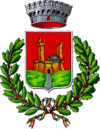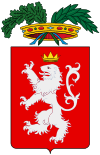Monteriggioni
| Monteriggioni | ||
|---|---|---|
| Comune | ||
| Comune di Monteriggioni | ||
 Panorama of Monteriggioni. | ||
| ||
 Monteriggioni Location of Monteriggioni in Italy | ||
| Coordinates: 43°23′24.01″N 11°13′23.95″E / 43.3900028°N 11.2233194°E | ||
| Country | Italy | |
| Region | Tuscany | |
| Province | Siena (SI) | |
| Frazioni | Abbadia a Isola, Badesse, Basciano, Belverde, Castellina Scalo, Ceppo, Colonna di Monteriggioni, Fontebecci, Quercegrossa, Riciano, Santa Colomba, Scorgiano, Stomennano, Strove, Uopini | |
| Government | ||
| • Mayor | Raffaella Senesi | |
| Area | ||
| • Total | 99.72 km2 (38.50 sq mi) | |
| Elevation | 200 m (700 ft) | |
| Population (30 November 2017)[1] | ||
| • Total | 9,921 | |
| • Density | 99/km2 (260/sq mi) | |
| Demonym(s) | Monteriggionesi | |
| Time zone | UTC+1 (CET) | |
| • Summer (DST) | UTC+2 (CEST) | |
| Postal code | 53035 | |
| Dialing code | 0577 | |
| Patron saint | Assumption of Mary | |
| Saint day | 15 August | |
| Website | Official website | |
Monteriggioni is a comune in the province of Siena in the Italian region of Tuscany. It borders on the communes of Casole d'Elsa, Castellina in Chianti, Castelnuovo Berardenga, Colle di Val d'Elsa, Poggibonsi, Siena and Sovicille.[2] The town is architecturally and culturally significant; it hosts several piazzas, and is referenced in Dante Alighieri's Divine Comedy.
History

Monteriggioni is a medieval walled town, located on a natural hillock, built by the Sienese in 1214–19 as a front line in their wars against Florence,[3] by assuming command of the Via Cassia running through the Val d'Elsa and Val Staggia to the west.
During the conflicts between Siena and Florence in the Middle Ages, the city was strategically placed as a defensive fortification.[4] It also withstood many attacks from both the Florentines and the forces of the Bishop of Volterra.[5] In 1554 the Sienese were able to place control of the town's garrison to Giovannino Zeti, who had been exiled from Florence.[6] In 1554, in an act of reconciliation with the Medicis, Zeti simply handed the keys of the town over to the Medicean forces— considered a "great betrayal" by the town's people.[2]
Main sights



The roughly circular walls, totalling a length of about 570 metres (1,870 ft) and following the natural contours of the hill, were built between 1213 and 1219. There are 14 towers on square bases set at equidistance, and two portals or gates. One gate, the Porta Fiorentina opens toward Florence to the north, and the other, the Porta Romana, faces Rome to the south. The main street within the walls connects the two gates in a roughly straight line.
The main piazza, the Piazza Roma, is dominated by a Romanesque church with a simple, plain façade. Other houses, some in the Renaissance style (once owned by local nobles, gentry and wealthy merchants) face into the piazza. Off the main piazza smaller streets give way to public gardens fronted by the other houses and small businesses of the town. In more hostile times, these gardens provided vital sustenance when enemies gathered without.
Other sights in the town's countryside include:
- Badia of Santi Salvatore e Cirino, at Abbadia Isola, a Romanesque abbey from the mid-12th century.
- Romanesque church of San Lorenzo a Colle Ciupi
- Romanesque Pieve of Santa Maria a Castello, known since as early as 971
- Romanesque-Gothic hermitage of San Leonardo al Lago
- Villa Santa Colomba
Cultural significance
The Tuscan poet Dante Alighieri used the turrets of Monteriggioni to evoke the sight of the ring of giants encircling the Infernal abyss.
As with circling round
Of turrets, Monteriggioni crowns his walls;
E’en thus the shore, encompassing the abyss,
Was turreted with giants, half their length
Uprearing, horrible, whom Jove from heaven
Yet threatens, when his muttering thunder rolls.[7]
Monteriggioni also plays a significant role in the games Assassin's Creed II and Assassin's Creed: Brotherhood, both of which are loosely based around certain key historical events in Renaissance Italy.[8] It is home to protagonist Ezio Auditore, and his uncle Mario, who lives in the fictional Villa Auditore.
Education
Public schools include:[9]
- Preschools (Scuole dell'Infanzia): C. Collodi, Don Muzzi, and Pinocchio
- Elementary schools (Scuole primare): I. Calvino, G. Rodari, and Don L. Milani
- One junior high school (Scuola secondaria di 1° grado): Scuola Media Statale "Dante Alighieri"
All public schools within the commune are a part of the Istituto Comprensivo Statale di Monteriggioni, School District #38.[10]
International School of Siena, a private international school, is in the commune.[11]
References
- ↑ Population data from Istat
- 1 2 "Tuscany Tours - Chianti tour n. 1". Retrieved 1 March 2010.
- ↑ Crump, Vincent (April 6, 2008). "Step up for Europe's top treks". London: The Sunday Times. Retrieved 1 April 2010.
- ↑ Miklas, Margie (7 March 2016). "Monteriggioni – Another Hilltop Town in Tuscany". L'Italo-Americano. Retrieved 27 May 2018.
- ↑ "Monteriggioni San Gimignano and Castellina in Chianti Fullday from Rome". Trip Republic. Rome. 2018. Retrieved 27 May 2018.
- ↑ Bucknall, Harry (17 July 2014). Like a Tramp, Like A Pilgrim: On Foot, Across Europe to Rome. A&C Black. p. 144. ISBN 9781408187265.
- ↑ Translated by Henry Francis Cary during the years 1805–1844
- ↑ Owen, Phil (2 November 2012). "Fact: Assassin's Creed II's Monteriggioni is a real place". vg247. Retrieved 24 April 2018.
- ↑ "Strutture Educative." Monteriggioni. Retrieved on October 22, 2016.
- ↑ Home. Istituto Comprensivo Statale di Monteriggioni. Retrieved on October 22, 2016.
- ↑ Home. International School of Siena. Retrieved on October 22, 2016.
External links
| Wikimedia Commons has media related to Monteriggioni. |
| Wikivoyage has a travel guide for Monteriggioni. |
 | |
|
|

